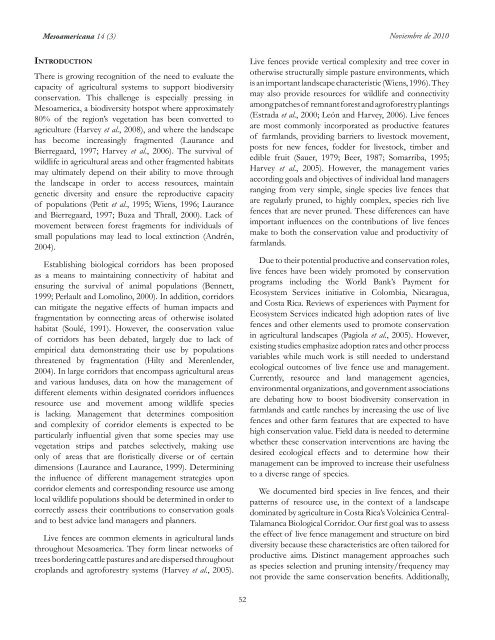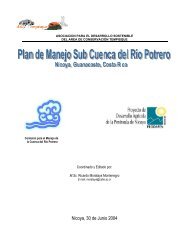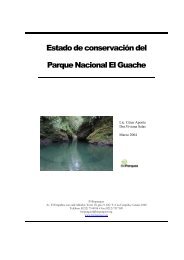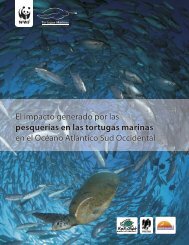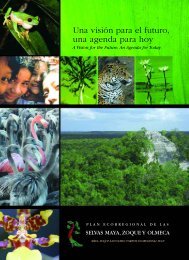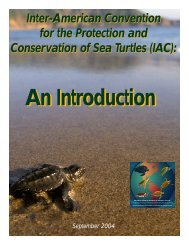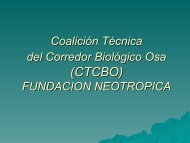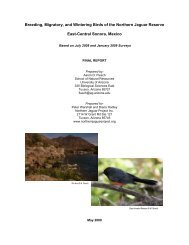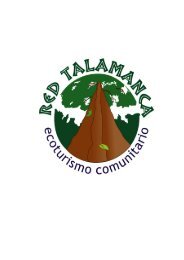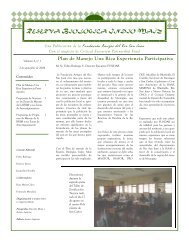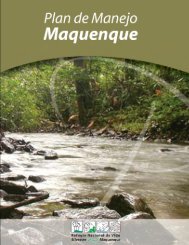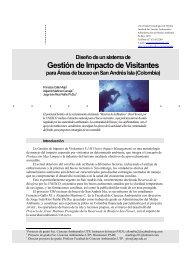Volumen 14(3) Noviembre de 2010 - Eco-Index
Volumen 14(3) Noviembre de 2010 - Eco-Index
Volumen 14(3) Noviembre de 2010 - Eco-Index
You also want an ePaper? Increase the reach of your titles
YUMPU automatically turns print PDFs into web optimized ePapers that Google loves.
Mesoamericana <strong>14</strong> (3) <strong>Noviembre</strong> <strong>de</strong> <strong>2010</strong>In t r o d u c t i o nThere is growing recognition of the need to evaluate thecapacity of agricultural systems to support biodiversityconservation. This challenge is especially pressing inMesoamerica, a biodiversity hotspot where approximately80% of the region’s vegetation has been converted toagriculture (Harvey et al., 2008), and where the landscapehas become increasingly fragmented (Laurance andBierregaard, 1997; Harvey et al., 2006). The survival ofwildlife in agricultural areas and other fragmented habitatsmay ultimately <strong>de</strong>pend on their ability to move throughthe landscape in or<strong>de</strong>r to access resources, maintaingenetic diversity and ensure the reproductive capacityof populations (Petit et al., 1995; Wiens, 1996; Lauranceand Bierregaard, 1997; Buza and Thrall, 2000). Lack ofmovement between forest fragments for individuals ofsmall populations may lead to local extinction (Andrén,2004).Establishing biological corridors has been proposedas a means to maintaining connectivity of habitat an<strong>de</strong>nsuring the survival of animal populations (Bennett,1999; Perlault and Lomolino, 2000). In addition, corridorscan mitigate the negative effects of human impacts andfragmentation by connecting areas of otherwise isolatedhabitat (Soulé, 1991). However, the conservation valueof corridors has been <strong>de</strong>bated, largely due to lack ofempirical data <strong>de</strong>monstrating their use by populationsthreatened by fragmentation (Hilty and Merenlen<strong>de</strong>r,2004). In large corridors that encompass agricultural areasand various landuses, data on how the management ofdifferent elements within <strong>de</strong>signated corridors influencesresource use and movement among wildlife speciesis lacking. Management that <strong>de</strong>termines compositionand complexity of corridor elements is expected to beparticularly influential given that some species may usevegetation strips and patches selectively, making useonly of areas that are floristically diverse or of certaindimensions (Laurance and Laurance, 1999). Determiningthe influence of different management strategies uponcorridor elements and corresponding resource use amonglocal wildlife populations should be <strong>de</strong>termined in or<strong>de</strong>r tocorrectly assess their contributions to conservation goalsand to best advice land managers and planners.Live fences are common elements in agricultural landsthroughout Mesoamerica. They form linear networks oftrees bor<strong>de</strong>ring cattle pastures and are dispersed throughoutcroplands and agroforestry systems (Harvey et al., 2005).Live fences provi<strong>de</strong> vertical complexity and tree cover inotherwise structurally simple pasture environments, whichis an important landscape characteristic (Wiens, 1996). Theymay also provi<strong>de</strong> resources for wildlife and connectivityamong patches of remnant forest and agroforestry plantings(Estrada et al., 2000; León and Harvey, 2006). Live fencesare most commonly incorporated as productive featuresof farmlands, providing barriers to livestock movement,posts for new fences, fod<strong>de</strong>r for livestock, timber an<strong>de</strong>dible fruit (Sauer, 1979; Beer, 1987; Somarriba, 1995;Harvey et al., 2005). However, the management variesaccording goals and objectives of individual land managersranging from very simple, single species live fences thatare regularly pruned, to highly complex, species rich livefences that are never pruned. These differences can haveimportant influences on the contributions of live fencesmake to both the conservation value and productivity offarmlands.Due to their potential productive and conservation roles,live fences have been wi<strong>de</strong>ly promoted by conservationprograms including the World Bank’s Payment for<strong>Eco</strong>system Services initiative in Colombia, Nicaragua,and Costa Rica. Reviews of experiences with Payment for<strong>Eco</strong>system Services indicated high adoption rates of livefences and other elements used to promote conservationin agricultural landscapes (Pagiola et al., 2005). However,existing studies emphasize adoption rates and other processvariables while much work is still nee<strong>de</strong>d to un<strong>de</strong>rstan<strong>de</strong>cological outcomes of live fence use and management.Currently, resource and land management agencies,environmental organizations, and government associationsare <strong>de</strong>bating how to boost biodiversity conservation infarmlands and cattle ranches by increasing the use of livefences and other farm features that are expected to havehigh conservation value. Field data is nee<strong>de</strong>d to <strong>de</strong>terminewhether these conservation interventions are having the<strong>de</strong>sired ecological effects and to <strong>de</strong>termine how theirmanagement can be improved to increase their usefulnessto a diverse range of species.We documented bird species in live fences, and theirpatterns of resource use, in the context of a landscapedominated by agriculture in Costa Rica’s Volcánica Central-Talamanca Biological Corridor. Our first goal was to assessthe effect of live fence management and structure on birddiversity because these characteristics are often tailored forproductive aims. Distinct management approaches suchas species selection and pruning intensity/frequency maynot provi<strong>de</strong> the same conservation benefits. Additionally,52


